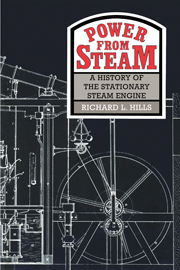Book contents
- Frontmatter
- Contents
- Preface
- Acknowledgements
- List of figures
- List of tables
- 1 The noblest machine
- 2 The impellent force of fire
- 3 Common old smoaking engines
- 4 The economy of power
- 5 The devil of rotations
- 6 Such unbounded power
- 7 Good servants but bad masters
- 8 An uncultivated field
- 9 The new theory of heat
- 10 The internal operation of the machine
- 11 Such absolute smoothness
- 12 Twinkle twinkle little arc
- 13 The drive for efficiency
- 14 An economical source of motive power
- 15 The most economical mode of obtaining power
- Notes
- Bibliography
- Index
14 - An economical source of motive power
The uniflow engine (1880–1940)
Published online by Cambridge University Press: 01 June 2011
- Frontmatter
- Contents
- Preface
- Acknowledgements
- List of figures
- List of tables
- 1 The noblest machine
- 2 The impellent force of fire
- 3 Common old smoaking engines
- 4 The economy of power
- 5 The devil of rotations
- 6 Such unbounded power
- 7 Good servants but bad masters
- 8 An uncultivated field
- 9 The new theory of heat
- 10 The internal operation of the machine
- 11 Such absolute smoothness
- 12 Twinkle twinkle little arc
- 13 The drive for efficiency
- 14 An economical source of motive power
- 15 The most economical mode of obtaining power
- Notes
- Bibliography
- Index
Summary
Right at the end of the reciprocating steam engine era appeared one based on different principles from earlier designs which enabled it to compete for a while not only with the steam turbine but also the diesel. In fact development work on it continued in the United States of America right up to the 1940s. It was called the ‘Uniflow’, or on the Continent and United States ‘Unaflow’, through the way in which the steam was used in the cylinder. Normally this type was double-acting with only inlet valves fitted at either end of the cylinder. The steam was exhausted through a central ring of ports in the middle of the cylinder which were closed by the movement of the piston. The piston had to be made almost as long as the length of the stroke, about 10 per cent less was customary. The steam entered at one end of the cylinder and pushed the piston along. Most of it escaped through the exhaust ports and what was left was compressed as the piston returned, raising its temperature. The attractive feature of the Uniflow engine was the good thermodynamic layout because the inlet end always remained hot and the centre with the exhaust stayed cold. The residual steam was reheated by the compression back to the temperature of the incoming steam so there was no heat loss through condensation.
- Type
- Chapter
- Information
- Power from SteamA History of the Stationary Steam Engine, pp. 258 - 280Publisher: Cambridge University PressPrint publication year: 1989



